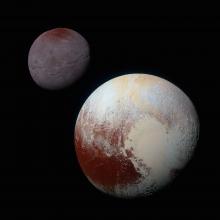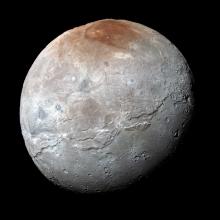Listen to today's episode of StarDate on the web the same day it airs in high-quality streaming audio without any extra ads or announcements. Choose a $8 one-month pass, or listen every day for a year for just $30.
You are here
Bright Heart
Pluto doesn’t wear its heart on its sleeve -- it wears it just above its waist. It’s a region that really does look like a cartoon version of a heart. Most of it is north of the equator.
The two lobes of the heart are different. The right half is rugged, and its outline is jagged. The left half is brighter and smoother, and its outline is better defined.
That side is called Sputnik Planitia. It’s a wide, shallow bowl that might have formed when a giant asteroid slammed into Pluto. Today, it’s filled with frozen nitrogen. There are few impact craters atop the ice, so the surface is young -- less than 200,000 years old.
The surface looks like the cracked bottom of a dry riverbed. The smooth segments between the cracks average about 20 miles across, and they’re higher in the middle than at the edges.
One possible reason for that appearance is that the nitrogen ice at the bottom of the basin is warmed by Pluto’s interior -- perhaps by a deep ocean of liquid water. The warm ice bubbles to the surface. It builds “domes” and pushes older ice toward the edges, where it cools and sinks to the bottom. It warms up again, then returns to the surface -- giving Pluto a bright heart.
Pluto is at its best for the year right now. It rises at sunset and is in view all night. It’s also at its brightest. Even so, you need a big telescope to spot it, near the border between Sagittarius and Capricornus.
More about Pluto tomorrow.
Script by Damond Benningfield






